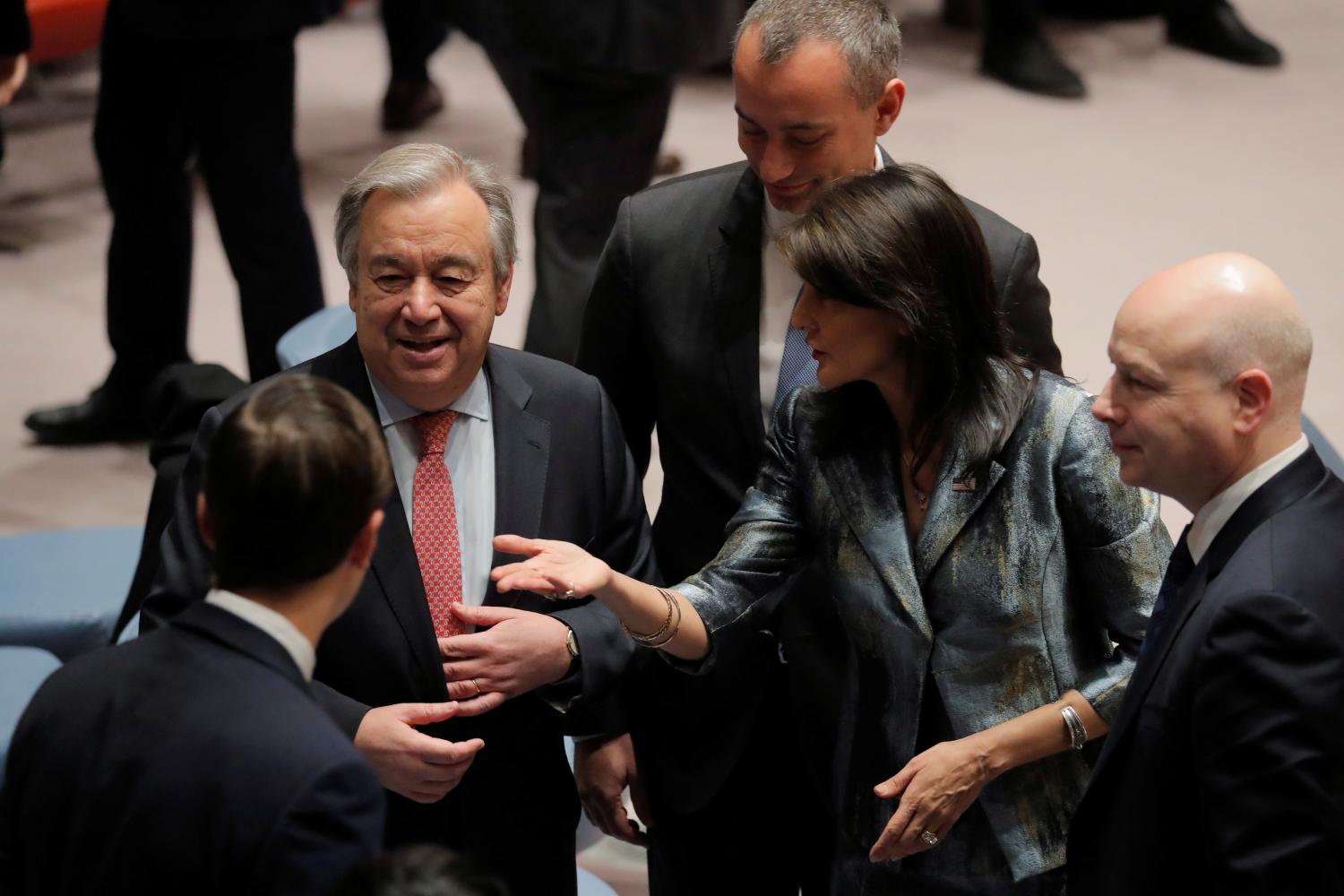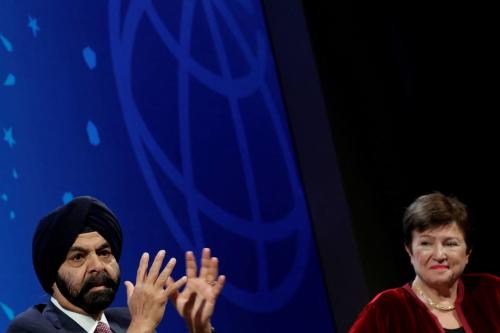From August 1-3, 2018, the Global Economy and Development Program at Brookings hosted the 15th annual Brookings Blum Roundtable on challenges to and opportunities for U.S. foreign assistance and global leadership. The following is one of six briefs related to this year’s theme: “Invigorating U.S. Leadership in Global Development.”
The U.S. has increasingly channeled its global development investments through the multilateral development system. Indeed, the United States was instrumental in organizing much of the current system, which includes a diverse set of organizations, from the economic focus of the World Bank Group; to the social development priorities of UN agencies; to purpose-specific funds such as the Global Fund for HIV/AIDs, Tuberculosis, and Malaria (GFATM) and the Global Partnership for Education (GPE).
This multilateral development system has grown to play a major role in in global development. In 20141, 41 percent of the Official Development Assistance (ODA) given by the OECD’s Development Assistance Committee (DAC), the forum of many of the world’s largest donors of aid, went through multilateral channels. Almost three fourths of this multilateral aid goes to support the core operations of individual multilateral organizations, with the rest supporting specific purposes or projects specified by the donors.
Evolution within the multilateral system is essential in today’s fast-changing context. The increased ambitions of the global community and the need for global public goods, reflected in agreements such as the Sustainable Development Goals (SDGs) and the Paris climate accord, are creating a demand for improved results and coordination. The growing size and political influence of emerging economies, the enhanced agency of many developing countries, and an increasingly complex set of transnational issues are also reshaping the global context for multilateralism.
Given this dynamic and complex environment, multilateral institutions are responding to ensure they are fit for purpose. U.N. Secretary General Antonio Guterres just received approval from member states for a major restructuring of the U.N. development system. President Jim Yong Kim devoted his first term to major reforms at the World Bank Group. And a G20 Eminent Persons Group on Global Financial Governance is reviewing the entire system of multilateral development banks, with recommendations due in October 2018.2
US investments in multilaterals
The U.S. has wide-ranging interests in the multilateral development system. It gave at least US$1 million to each of 65 different multilateral organizations and funds in 2016, and the share of U.S. aid channeled through multilateral organizations has increased substantially over the past decade. As overall U.S. aid rose from $24.6 billion in 2004 to $34.4 billion in 2016, the portion of that aid directed through multilateral channels grew from approximately one-fifth to one-third.
 Newer, purpose-driven multilateral institutions account for most of this increase in U.S. funding, reflecting significant investments in entities such as GFATM, GFE, GAVI, the Vaccine Alliance, and the Afghanistan Reconstruction Trust Fund. During the same time period, the share of U.S. ODA going to the World Bank Group and other multilateral development banks held steady, while the share to U.N. agencies slightly declined.
Newer, purpose-driven multilateral institutions account for most of this increase in U.S. funding, reflecting significant investments in entities such as GFATM, GFE, GAVI, the Vaccine Alliance, and the Afghanistan Reconstruction Trust Fund. During the same time period, the share of U.S. ODA going to the World Bank Group and other multilateral development banks held steady, while the share to U.N. agencies slightly declined.
This support for multilaterals and for U.S. engagement globally reflects the views of the American public. In a January 2017 report by the University of Maryland,3 an overwhelming majority of citizens agreed that “the U.S. should coordinate its power with other countries according to shared ideas of what is best for the world,” a pattern also recorded in 2006 and 2004.
However, the Trump Administration’s “America First” foreign policy has raised questions about the value of investing in multilateral institutions. The president’s 2018 budget reflected concerns about burden-sharing, suggesting that attention must be paid to the “appropriate U.S. share of international spending at the United Nations, at the World Bank, and for many other global issues.” The 2017 National Security Strategy stresses the importance of achieving better outcomes in multilateral fora.
In late 2017, Senator Robert Corker (R-TN) and Senator Chris Coons (D-DE) introduced the Multilateral Aid Review Act of 2017,4 legislation that mandates a regular review of the multilateral development institutions funded by the U.S. government. The review criteria would grade individual organizations on: (1) their performance and effectiveness; and (2) their alignment with U.S. foreign policy interests.
The issues intended to be addressed by a review are varied: whether the organizations are well-run, efficient, and have the right level of staff, structure, and administration; whether they maximize their impact and nimbly respond to quick-changing environments; and whether their mandates and areas of operation match the specific policy interests of the U.S. The legislation suggests a methodology that would provide a systematic and data-driven approach to assessing the organizational strength and performance of the funded multilateral organizations and the return on investment to the U.S. taxpayer. It is based on assessments that other bilateral donors have undertaken in recent years, including the U.K., Australia, Denmark, Norway, and the Netherlands, as well as those done by the Multilateral Organization Performance Assessment Network (MOPAN).
The U.S. has never formally undertaken such a comprehensive review of all the multilateral development agencies it funds. Presenting an objective measure of performance and organizational effectiveness would provide individual institutions with incentives for improvement and help create a “race to the top.” For example, the International Organization for Migration (IOM) and the Food and Agriculture Organization (FAO), which both scored comparatively low in a U.K. multilateral aid review in 2011, subsequently pursued reforms that significantly strengthened their organizations.
Such assessments would provide evidence for transparent decisionmaking and maximizing the return on investment to the U.S. taxpayer. For example, the U.S. has just decided not to renew its pledges to the International Fund for Agricultural Development (IFAD) and the Global Agricultural and Food Security Program (GAFSP). Yet IFAD was in the top percentile of performance of an organizational assessment completed in 2016 by the U.K., and the early development results from GAFSP are promising, raising questions about the U.S. decision—especially as food security is a key development priority.
Such decisions about funding specific multilaterals are generally made on a case-by-case basis. Yet U.S. involvement in the multilateral development system is not only broad—it is also deep. A recent analysis of the revenues of 53 multilateral institutions between 2014-2016 found that the U.S. was the top funder of 24 organizations. Japan and the U.K. were the next closest, with nine organizations each.5
Relying upon a discreet, case-by-case approach underplays the importance of the multilateral development system to the strategic interests of the U.S. The norms, practices, and standards that have been developed and shared within the system serve as the DNA for global cooperation and the provision of global public goods. Those standards are largely a legacy of a sense of shared purpose among like-minded donors, marked by a commitment to human rights and democratic institutions.6 The U.S.has wielded significant influence in creating these shared values and enjoys strategic benefits from its leadership within the system.
Such a view takes on increased importance for the U.S. as the system continues to evolve. Major new entrants—such as the Asian Infrastructure Investment Bank (AIIB), organized by China, and the New Development Bank (NDB), first proposed by India—have a different provenance and outlook. These new entities are substantial—China is making a $60 billion combined contribution to complement their planned investment of more than $1 trillion in its Belt and Road Initiative. Such newcomer organizations led by emerging economies increase options both for developing nations seeking finance as well as countries interested in becoming shareholders and donors.
Conclusion
The U.S., as an originator and investor, wields significant influence and advances its global development and strategic interests through the multilateral development system.
The U.S. should develop a coherent multilateral policy, transparently identifying the key attributes of multilateralism that it finds valuable and prioritizes. U.S. multilateral aid, for example, has helped leverage and crowd in investments from other countries on key U.S. development priorities. Such a policy would also transparently lay out criteria for decreases in particular agencies and anticipate related consequences. U.S. entries, increases, reductions, or exits in multilateral organizations should be viewed systemically, in light of the opportunities they provide to others to elevate their leadership or influence.
As part of this, a U.S. multilateral aid review would be a welcome contribution to improving both the multilateral development system and the effectiveness of U.S. development assistance. This will help maximize the return on U.S. aid while insulating decisions from subjective and potentially inconsistent rationales that might unduly penalize successful organizations and undermine U.S. credibility.
Further American retreat from multilateral institutions will erode the power of U.S. strategic values throughout the system. This will, in turn, reduce the ability “to shape developments that are positive for the United States” within the multilateral system—a stated priority in the Trump administration’s 2017 National Security Strategy. Reducing American participation would be akin to prioritizing quarterly earnings over long-term shareholder value—and would be a bad deal for the U.S. taxpayer.
-
Footnotes
-
OECD (2015), Multilateral Aid 2015: Better Partnerships for a Post-2015 World, OECD Publishing, Paris,
http://dx.doi.org/10.1787/9789264235212-en. -
Terms of Reference: G20 Eminent Persons Group on Global Financial Governance, May 21, 2017.
http://www.iai.it/sites/default/files/g20-epg-terms-of-reference.pdf. - Americans on the U.S. Role in the World: A Study of U.S. Public Attitudes.
- https://www.congress.gov/bill/115th-congress/senate-bill/1928/text.
- McArthur and Rasmussen, Who Funds Which Multilaterals? Global Views paper No. 8, The Brookings Institution, December 2017.
- For example, the OECD’s mission statement highlights that “the common thread of our work is a shared commitment to market economies backed by democratic institutions and focused on the well-being of all citizens.”
-
OECD (2015), Multilateral Aid 2015: Better Partnerships for a Post-2015 World, OECD Publishing, Paris,
http://dx.doi.org/10.1787/9789264235212-en.
http://www.iai.it/sites/default/files/g20-epg-terms-of-reference.pdf.




